Phylogenetic - Study guides, Class notes & Summaries
Looking for the best study guides, study notes and summaries about Phylogenetic? On this page you'll find 1069 study documents about Phylogenetic.
Page 3 out of 1.069 results
Sort by
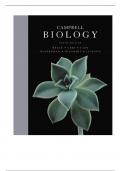
-
Test bank Campbell Biology (11th Revised Edition) Textbook
- Exam (elaborations) • 1244 pages • 2023
-
- $7.09
- 4x sold
- + learn more
Campbell Biology, 11e (Urry) Chapter 1 Evolution, the Themes of Biology, and Scientific Inquiry 1.1 Multiple-Choice Questions 1) Cells are . A) only found in pairs, because single cells cannot exist independently B) limited in size to 200 and 500 micrometers in diameter C) characteristic of eukaryotic but not prokaryotic organisms D) characteristic of prokaryotic and eukaryotic organisms Answer: D Bloom's Taxonomy: Knowledge/Comprehension Section: 1.1 2) In comparison to eukaryot...
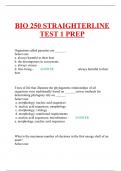
-
BIO 250 STRAIGHTERLINE TEST 1 PREP
- Exam (elaborations) • 38 pages • 2024
- Available in package deal
-
- $11.49
- + learn more
BIO 250 STRAIGHTERLINE TEST 1 PREP Organisms called parasites are ______. Select one: a. always harmful to their host b. the decomposers in ecosystems c. always viruses d. free-living - ANSWER always harmful to their host Trees of life that illustrate the phylogenetic relationships of all organisms were traditionally based on ______; newer methods for determining phylogeny rely on ______. Select one: a. morphology; nucleic acid sequences ...

-
BIOL 205 - Comparative Invertebrate Zoology (exam prep solution for December 2024 COVERING MIDTERM 1,2,3,4 AND FINAL EXAM) University of British Columbia, Okanagan Campus
- Exam (elaborations) • 35 pages • 2024
-
- $11.99
- + learn more
BIOL 205 - Comparative Invertebrate Zoology (exam prep solution for December 2024 COVERING MIDTERM 1,2,3,4 AND FINAL EXAM) University of British Columbia, Okanagan Campus Midterm 1: Invertebrate phyla including Porifera, Placozoa, Cnidaria, Ctenophora, Platyhelminthes, Acoela, Clade Gnathifera, and Gastrotricha material for the final exam. Covering Arthropoda, Echinodermata, and Hemichordata. Midterm 2 material. Includes Nemertea, Mollusca, Annelida, Cycliophora, Entoprocta, Ectoprocta, Bra...

-
Anthro 2B Final (Egan) verified answers and questions 2023.
- Exam (elaborations) • 13 pages • 2023
-
- $10.49
- 1x sold
- + learn more
Anthro 2B Final (Egan) verified answers and questions 2023. macro-evolution - correct tion above the species level micro-evolution - correct tion below the species level speciation - correct s when one species splits into two, which involves a reproductive isolating mechanism example of reproductive isolation but NOT speciation - correct rd frogs in Florida vs. Maine, can still reproduce but just can't because they are isolated; gene flow can happen extrinsic is...
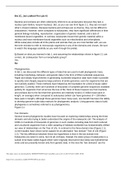
-
Bis 2C, Pre-Lab 2 (Graded A+)
- Exam (elaborations) • 9 pages • 2023
-
Available in package deal
-
- $7.99
- 3x sold
- + learn more
Bis 2C, Pre-Lab #2 Bacteria and Archaea are often collectively referred to as prokaryotes because they lack a nucleus (pro=before, karyon=nucleus). But, as you can see from figure 2.1, they are not each other’s closest relatives. Because bacteria and archaea are so diverse, they can be difficult to characterize. However, when compared to eukaryotes, they have significant differences in their general biology including, reproduction, organization of genetic material, and a lack of membrane...
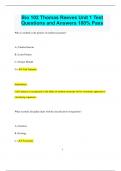
-
Bio 102 Thomas Reeves Unit 1 Test Questions and Answers 100% Pass
- Exam (elaborations) • 26 pages • 2024
-
- $9.99
- + learn more
Bio 102 Thomas Reeves Unit 1 Test Questions and Answers 100% Pass Who is credited as the pioneer of modern taxonomy? A.) Charles Darwin B.) Louis Pasteur C.) Gregor Mendel D.) Carl Linnaeus Explanation: Carl Linnaeus is recognized as the father of modern taxonomy for his systematic approach to classifying organisms. What scientific discipline deals with the classification of organisms? A.) Genetics B.) Ecology C.) Taxonomy 2 D.) Geology Explanation: Taxonomy is...
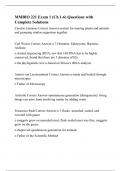
-
MMBIO 221 Exam 1 (Ch 1-6) Questions with Complete Solutions
- Exam (elaborations) • 32 pages • 2024
-
- $15.49
- + learn more
Carolus Linnaeus Correct Answer-system for naming plants and animals and grouping similar organisms together Carl Woese Correct Answer-o 3 Domains: Eukaryotes, Bacteria, Archaea o started sequencing rRNA, saw that 16S RNA has to be highly conserved, found that there are 3 domains of life o the phylogenetic tree is based on Woese's rRNA analysis Antoni van Leeuwenhoek Correct Answer-o made and looked through microscopes o Father of Microscopy Aristotle Correct Answer-spontaneous gene...
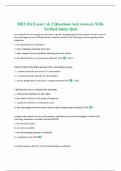
-
BIO 116 Exam 1 & 2 Questions And Answers With Verified Study Quiz
- Exam (elaborations) • 33 pages • 2024
-
Available in package deal
-
- $15.99
- + learn more
BIO 116 Exam 1 & 2 Questions And Answers With Verified Study Quiz you identify two new organisms that share a specific morphological feature. genetic analysis reveals that each organism uses different protein structure. which of the following are true regarding these organisms 1. the shared feature is analogous 2. these organisms represent sister taxa 3. their common ancestor probably did not possess this feature 4. the shared feature is a homologous character ANS 1 and 3 identify which...
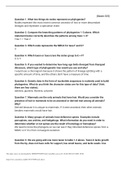
-
Pre-lab 1 (QUESTIONS AND ANSWERS) University of California, Davis BIS 2C 002C
- Exam (elaborations) • 3 pages • 2023
-
Available in package deal
-
- $5.49
- 5x sold
- + learn more
Question 1. What two things do nodes represent on phylogenies? Nodes represent the most recent common ancestor of two or more descendant lineages and represent a speciation event. Question 2. Compare the branching patterns of phylogenies 1-3 above. Which statement below correctly describes the patterns among trees 1-3? Tree 1 = Tree 2 Question 3. Which node represents the MRCA for taxa F and G? 3 Question 4. Which taxon or taxa is/are the sister group to E + F? D, G, H Question 5. If y...
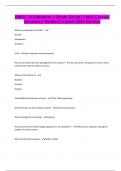
-
BMSC 210 Midterm 1 Study Guide | 100% Correct Answers | Verified | Latest 2024 Version
- Exam (elaborations) • 30 pages • 2024
- Available in package deal
-
- $13.49
- + learn more
What are properties of all cells? - Growth Metabolism Evolution LUCA - Last universal common ancestor How do we decide how the phylogenetic tree is drawn? - Use ribosomes. All organisms have it and it has been the same for billions of years What are the domains? - Bacteria Archaea Eukarya What defines the domains of cells? - Their rRNA sequencing What domains are most closely related? - Archaea and eukarya What emerged from Archaea? - Eukarya How do we know kw when oxygen appeare...

How did he do that? By selling his study resources on Stuvia. Try it yourself! Discover all about earning on Stuvia


